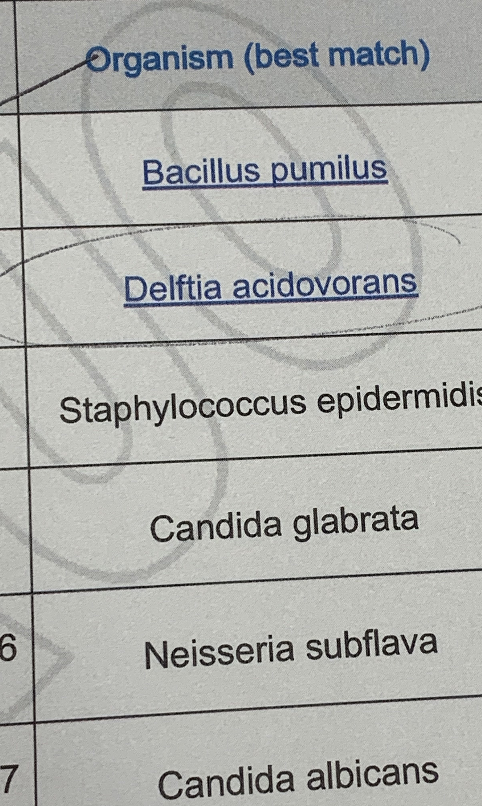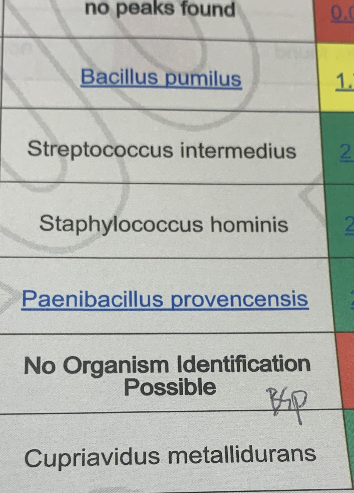Unlikely pathogens
Going through the daily routines at work can sometimes yield interesting educational tidbits. Working in the lab, the MALTI-TOF has often revealed organisms not taught in schools. Often, we don't know the significance of these microbes to the patients' etiology. That's above my pay grade.
Recently, I noticed two bacteria I have never seen before: Delftia acidovorans and Cupriavidus metallidurans.
They are from two different patients over one of the weeks I worked, and both of them were respiratory cultures. Both organisms have similar uses in their utilities.

Delftia acidovorans can metabolize gold. Who knew? It can degrade toxic metal products and is a big part of bioremediation processes.

Cupriavidus metallidurans is another hardy bacteria that can survive a toxic environment. As it turns out, they can precipitate gold ions with D. acidovorans.
Their feat led me to read into bioremediation. It's a fancy term for treating pollutants using biological agents. Things like petroleum spills, pesticides, and whatnot, fall under its applications. I never learned about this as my emphasis is in clinical microbiology. I have wondered if this could be an alternative to a midlife crisis at some point.
As cool as the field sounds, it does have its limitations. The Wikipedia article does mention toxic byproducts as a result of the degradation process. When it comes to GMOs developed for bioremediation, it does open up an entire can of worms. We certainly don't want to release anything that would impact the environment in unforeseen ways.
Regardless, I found it fascinating that the skills I learned in university apply to this field should I pursue a different study. It may be too late (I'm 33), but it's good to learn more about how expertise interconnects with one another.
Posted with STEMGeeks
Nice work!

!1UP
Thanks for sharing this is my first time hearing of such bacteria
Mother nature be interesting.
Your post reminded me of an article I read these days about bacteria that were reprogrammed to break down CO2, I think they were E. Coli! interesting post!
The difference here is they haven't been able to engineer E. coli to do the things these guys can do.
Thank you for your witness vote!
Have a !BEER on me!
To Opt-Out of my witness beer program just comment !STOP below
View or trade
BEER.Hey @enforcer48, here is a little bit of
BEERfrom @isnochys for you. Enjoy it!Learn how to earn FREE BEER each day by staking your
BEER.Wow 😮. Never thought there's something like that. Wait, does gold rust? 🤔
It doesn't, that's why it's pretty crazy.
I think I'm gonna read more about this microorganism then. This is interesting tho
Thank you for your witness vote!
Have a !BEER on me!
To Opt-Out of my witness beer program just comment !STOP below
View or trade
BEER.Hey @enforcer48, here is a little bit of
BEERfrom @isnochys for you. Enjoy it!Learn how to earn FREE BEER each day by staking your
BEER.You have received a 1UP from @lipe100dedos!
@ctp-curator, @stem-curator, @vyb-curator, @pob-curator, @neoxag-curator, @pal-curatorAnd they will bring !PIZZA 🍕
Learn more about our delegation service to earn daily rewards. Join the family on Discord.
Congratulations @enforcer48! You have completed the following achievement on the Hive blockchain and have been rewarded with new badge(s):
Your next payout target is 21000 HP.
The unit is Hive Power equivalent because post and comment rewards can be split into HP and HBD
You can view your badges on your board and compare yourself to others in the Ranking
If you no longer want to receive notifications, reply to this comment with the word
STOPCheck out the last post from @hivebuzz:
Support the HiveBuzz project. Vote for our proposal!
Thanks for your contribution to the STEMsocial community. Feel free to join us on discord to get to know the rest of us!
Please consider delegating to the @stemsocial account (85% of the curation rewards are returned).
You may also include @stemsocial as a beneficiary of the rewards of this post to get a stronger support.